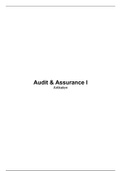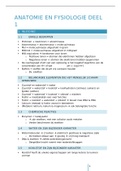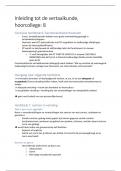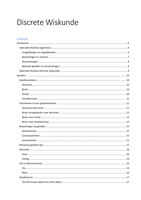Artikelen
,Inhoudsopgave
Pagina 3
Brazel, Jones & Prawitt (2014)
Auditors’ Reactions to Inconsistencies between Financal and Nonfinancial Measures: The Interactive
Effects of Fraude Risk Assessment and a Decision Prompt
Pagina 30
Brouwer, Eimers & Langendijk (2016)
De kernpunten uit de uitgebreide controleverklaring in relatie tot de risico’s in het bestuursverslag en
de schattingen en oordelen in de toelichting
Pagina 47
Gortemaker (2016)
Bestuursverslag en Assurance
Pagina 55
Junior, Best & Cotter (2014)
Sustainability Reporting and Assurance: A Historical Analysis on a World-Wide Phenomenon
Pagina 67
Omoteso, Patel & Scott (2010)
Information and Communications Technology and Auditing: Current Implications and Future Directions
Pagina 84
Brown-Liburd & Zamora (2015)
The Role of Corporate Social Responsibility (CSR) Assurance in Investors’ Judgments When
Managerial Pay is Explicitly Tied to CSR Performance
Pagina 121
Van Bommel & Goor (2005)
IT-auditing afbakenen in het kader van de jaarrekeningcontrole
Pagina 132
Bos, De Jong & Strating (2020)
Kernpunten van de controle en de transparantie erover in bestuursverslag, verslag van de raad van
commissarissen en de jaarrekening
Pagina 143
IFAC (2015)
Creating value with Integrated thinking, the role of accountants
Pagina 157
NBA (2017)
Green paper: De definitie van audit kwaliteit
Pagina 170
Stefaniak, Houston & Brandon (2017)
Investigating Inspection Risk: An Analysis of PCAOB Inspections and Internal Quality Reviews
Pagina 189
Van Bommel, Van Goor & Winterink (2006)
De betekenis van IT-auditing voor de jaarrekeningcontrole ontrafeld!
Pagina 197
Bos & Leonards (2014)
De accountant binnen het corporate governance bouwwerk
,Brazel, Jones & Prawitt (2014)
Context
Inconsistentie tussen de financiële prestaties van een bedrijf en gerelateerde niet-financiële
maatstaven (zoals de opslagruimte of het werknemersbestand) is voor veel investeerders een
mogelijke rode vlag als het gaat om financiële verslaggevingsfraude.
Theorie
Bij cijferbeoordelingen wordt de post van vorig jaar vaak als uitgangspunt genomen. Het management
kan echter fictieve boekingen maken in de financiële data om het patroon te creëren dat van tevoren
door de accountant verwacht wordt. Niet-financiële informatie is des te meer belangrijk, omdat het een
unieke en krachtige bron van bewijs is. Bedrijven die frauderen, vertonen in de praktijk bovendien
vaak inconsistenties tussen hun financiële data en gerelateerde NFM’s. Uit onderzoek blijkt dat
accountant bij hun werkzaamheden niet vaak steunen op NFM’s.
Een geheugensteuntje (prompt) kan de aandacht van accountants richten op NFM’s die in lijn zouden
moeten zijn met de financiële prestaties. Volgens het heuristic-systematic model (HSM) zal de
opvallendheid van het geheugensteuntje en de mate van reactie van de accountant afhankelijk zijn
van het niveau van risico dat hoort bij de opdracht. Als het frauderisico hoog is, zullen accountants
meer op hun houde zijn, het geheugensteuntje gebruiken, zich focussen op inconsistenties en
steunen op NFM-bewijs. Als het frauderisico laag is, zullen accountants terugvallen op automatische
verwerking, het geheugensteuntje negeren en minder steunen op NFM-bewijs.
Onderzoeksdoelen
• Onderzoeken in welke mate accountants inconsistenties tussen financiële data en NFM’s
identificeren en in twijfel trekken.
• Onderzoeken of en hoe accountants reageren op dergelijke inconsistenties en hoe dat
verbeterd kan worden.
Hypotheses
1. Accountants reageren over het algemeen niet op inconsistenties tussen financiële data en
gerelateerde NFM’s.
2. Een geheugensteuntje kan de aandacht van accountants voor dergelijke inconsistenties
verbeteren.
3. De effectiviteit van het geheugensteuntje is afhankelijk van de frauderisicobeoordeling voor
die specifieke opdracht.
Onderzoeksmethode
Twee experimenten met 110 senior accountants.
Het eerste experiment bevatte twee condities (consistente of niet-consistente NFM’s). In dit
experiment moesten accountants een verwachting vormen van de verkopen. Uitkomst: accountants
namen de NFM’s niet mee in hun beoordeling, ongeacht of er een inconsistentie is of niet.
Het tweede experiment was ongeveer gelijk aan het eerste, maar nu was er in alle situaties sprake
van inconsistentie, werd er gemanipuleerd met het frauderisico (hoog/laag) en werden participanten
na het vormen van hun initiële verwachting erop gewezen om expliciet de impact van NFM’s in hun
overweging mee te nemen en een uiteindelijke verwachting te formuleren. Uitkomst: geen direct effect
van het frauderisico op de initiële verwachtingen, maar accountants steunen meer op NFM’s bij het
vormen van hun uiteindelijke verwachting als ze daarop gewezen worden en met name als het
frauderisico hoog is.
Conclusie
Slechts weinig accountants nemen NFM’s mee in hun beoordeling en dit aantal neemt niet toe als
NFM’s wijzen op een rode vlag. De aanwezigheid van een hoog frauderisico alleen is onvoldoende om
dit te doen toenemen. Auditors reageren wel gepast op een inconsistentie als ze daaraan herinnerd
worden en dit effect is sterker als het frauderisico hoog is.
,BEHAVIORAL RESEARCH IN ACCOUNTING American Accounting Association
Vol. 26, No. 1 DOI: 10.2308/bria-50630
2014
pp. 131–156
Auditors’ Reactions to Inconsistencies
between Financial and Nonfinancial
Measures: The Interactive Effects of Fraud
Risk Assessment and a Decision Prompt
Joseph F. Brazel
North Carolina State University
Keith L. Jones
George Mason University
Douglas F. Prawitt
Brigham Young University
ABSTRACT: Nonfinancial measures (NFMs), such as employee headcount and
production space, are operational measures that are not included on the face of the
financial statements but are often disclosed elsewhere in the annual report or 10-K (e.g.,
in Management’s Discussion and Analysis). Professional standards, auditing texts, and
prior research suggest that external auditors can use NFMs to verify their clients’
reported financial information and, in turn, improve audit quality. In an initial experiment
where auditors develop an expectation for a client’s sales balance, they generally fail to
identify a seeded inconsistency between the client’s sales and related NFMs. In our
second experiment, where we introduce an NFM prompt and manipulate fraud risk as
We are grateful for the helpful comments provided by two anonymous reviewers, James L. Bierstaker (associate editor),
Vicky Arnold (editor), Chris Agoglia, Paul Beswick, Brian Croteau, Steve Glover, Erin Hamilton, Rick Hatfield, Rich
Houston, Kathryn Kadous, James Kroeker, Kathleen Linn, Linda Parsons, Mark Peecher, Sean Peffer, Dave Piercey,
Dick Riley, Chad Simon, Gary Taylor, Rick Warne, Jeff Wilks, David Wood, and Mark Zimbelman. We also thank
workshop participants at The University of Alabama, the 2009 Accounting, Behavior and Organizations Research
Conference, the 2010 Auditing Midyear Meeting, the 2010 Public Company Accounting Oversight Board Academic
Conference, the 2010 Inaugural Conference on Financial Reporting, Auditing and Governance, the 2010 International
Symposium on Audit Research, the 2010 AAA Annual Meeting, the 2010 Annual Meeting of the Institute for Fraud
Prevention, the 2012 Mid-Atlantic Region Conference for the Institute of Internal Auditors, the 2012 Meeting of the
Association of Certified Fraud Examiners–Central Carolina Chapter, the Raleigh-Durham chapter of the Institute of
Internal Auditors, the Research Center on the Prevention of Financial Fraud, and the Office of the Chief Accountant of
the Securities and Exchange Commission. We appreciate the support of the audit professionals who participated in this
study and the research assistance of Kylee Phillips and Marycobb Randall. This research was supported by a grant from
the Financial Industry Regulatory Authority (FINRA) Investor Education Foundation.
All results, interpretations, and conclusions expressed are those of the authors alone, and do not necessarily represent the
views of the FINRA Investor Education Foundation or any of its affiliated companies.
James L. Bierstaker, Associate Editor.
Published Online: October 2013
131
, 132 Brazel, Jones, and Prawitt
high and low, auditors are more likely to react to the inconsistency (i.e., rely more on
inconsistent NFMs/develop expectations that reflect the client’s current year decline in
NFMs) when they are specifically prompted to consider the implications of NFMs and
fraud risk is high (versus low). Our results suggest the following: (1) a minority of auditors
use NFMs as an information source for testing and do not increase their reliance on
NFMs when the NFMs point to a fraud red flag; (2) the presence of high fraud risk alone
is insufficient to increase auditor consideration of inconsistent NFMs; (3) auditors are
able to react appropriately to an inconsistency if they are effectively prompted; and (4)
the influence of a prompt on auditor reliance on NFMs and account balance expectations
is stronger when fraud risk is assessed as high.
Keywords: analytical procedures; audit; fraud; nonfinancial measures.
Data Availability: Data are available upon request.
INTRODUCTION
C
apital market participants and other stakeholders in the financial reporting process indicate
that fraud detection is among their highest priorities (Elliott 2002; PCAOB 2003, 2007).
Professional standards (e.g., AICPA 2002), auditing texts (e.g., Messier, Glover, and
Prawitt 2012), and prior research (e.g., Brazel, Jones, and Zimbelman 2009) suggest that an
inconsistency between a company’s financial performance and related nonfinancial measures (e.g.,
number of retail outlets, warehouse space, employee headcount) represents a potential red flag with
respect to financial statement fraud.1 For example, lawsuits against the auditors of Bernard L.
Madoff Investment Securities LLC and its feeder funds claim that the auditors could have identified
the fraud by noting the inconsistency between Madoff’s bloated balance sheet and the firm’s
minimal trading volume (Dugan and Crawford 2009; Lauricella 2009).
The Public Company Accounting Oversight Board (PCAOB) has discussed the potential for
nonfinancial measures (NFMs) to provide a powerful, independent benchmark for evaluating the
validity of financial statement data and has endorsed the use of NFMs to improve fraud detection
(PCAOB 2004). A recent archival study tests these conjectures and finds that, for fraud firms,
growth in sales significantly exceeds growth in related NFMs (Brazel et al. 2009). By contrast,
Brazel et al. (2009) and other studies find NFMs to be relatively consistent with financial statement
data for non-fraud firms (e.g., Ittner and Larcker 1998). Thus, there is reason to believe that auditor
consideration of inconsistencies between financial statement data and NFMs could improve the
detection of fraudulent financial reporting (hereafter, fraud). Such improvements are needed as
recent evidence suggests that the media, employees, analysts, and short sellers are all more likely
than the auditor is to detect fraud (Dyck, Morse, and Zingales 2010).
Results from recent archival studies raise the possibility that auditor attention to NFMs is
insufficient to detect inconsistencies between financial data and NFMs (Brazel et al. 2009; Dechow,
Ge, Larson, and Sloan 2011). However, such archival research is limited in that it is unable to
directly examine the process by which auditors may or may not detect such inconsistencies. Failure
to detect fraud may not be the result of auditors not considering NFMs, but rather due to other
problems in the audit process such as poorly designed fraud tests (e.g., Asare and Wright 2004;
Hammersley, Johnstone, and Kadous 2011). Our first objective is to leverage the experimental
method to directly explore the extent to which auditors identify and question inconsistencies
1
We use the term inconsistency to describe the inconsistencies between financial data and related NFMs that fraud
firms tend to exhibit. For example, for fraud firms, Brazel et al. (2009) find that sales growth exceeds NFM
growth by approximately 25 percent (inconsistency), whereas sales growth exceeds NFM growth by
approximately 10 percent for non-fraud firms (greater consistency).
Behavioral Research In Accounting
Volume 26, Number 1, 2014











